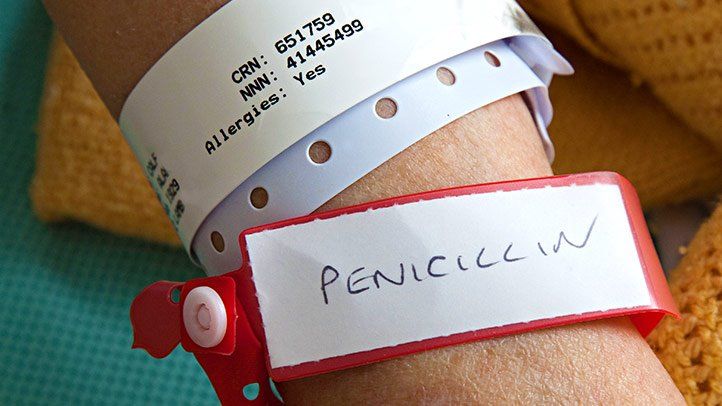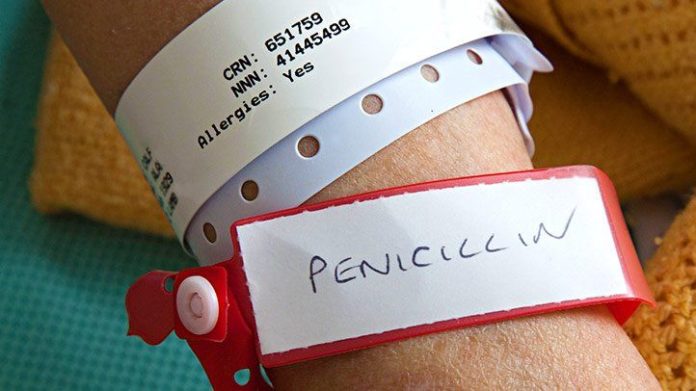Syphilis is a bacterial infection that's typically spread through sexual contact.
The first sign of syphilis is most commonly a painless sore, called a chancre, that develops where the bacteria entered the body. The chancre typically appears within three weeks from the time of exposure. It is usually in the area of the genitals, rectum, or mouth, and it can go unnoticed if it is hidden inside the body.
The infection spreads from person to person when a person touches these sores with their skin or mucous membranes.
Syphilis can be difficult to diagnose, because after the initial infection, the bacteria can lie dormant in the body for years before becoming active again. With no visible symptoms, the only way to know that you have syphilis is to be tested for it, which usually involves having a blood sample taken, according to Lab Tests Online. (1)
Syphilis can be a serious, even life-threatening illness if it goes untreated. It’s especially dangerous when passed from an infected mother to her infant during pregnancy or childbirth.
With the number of cases of syphilis, including congenital syphilis, on the rise in the United States and elsewhere in the world, the Centers for Disease Control and Prevention (CDC) is recommending annual or even more frequent screening for those individuals at high risk, and numerous state and local health departments are mounting awareness campaigns. (2)
Fortunately, there are several very effective treatments available to kill the bacteria that causes syphilis, and the infection is easily curable in adults when treated early. It can be treated at later stages as well, but treatment cannot reverse any organ damage the disease may have already caused.
Signs and Symptoms of Syphilis
A person can have syphilis and not see or feel any symptoms, which is one reason it’s such a common infection. It’s also easy to confuse syphilis with other things, such as pimples or rashes, notes Planned Parenthood. (3)
The symptoms of syphilis are different depending on what stage the disease is in.
Primary Stage
There may be single or multiple sores, which are usually firm, round, and painless and can often go unnoticed. The sore(s) typically last three to six weeks with or without treatment. Even after the sore goes away, treatment is necessary to stop the infection from progressing to the secondary stage, per the CDC. (4)
Secondary Stage
This stage usually begins with a rash on one or more areas of the body. The rash can appear as rough, red or reddish-brown spots, but sometimes it’s very faint and not noticeable. Other symptoms of syphilis that can come in the secondary stage can include the following: (4)
- Sores in the mouth, vagina, or anus
- Fever
- Swollen lymph glands
- Sore throat
- Patchy hair loss
- Headaches
- Weight loss
- Muscle aches
- Fatigue
Without proper treatment, the infection will progress to the latent and possibly tertiary stages.
Latent Syphilis
If syphilis goes untreated, it moves from the secondary stage to the latent or hidden phase, where there are no symptoms. This stage can last for years, and the signs and symptoms may never come back or the disease can progress to the third, or tertiary stage, according to the Mayo Clinic. (5)
Tertiary Syphilis
Approximately 15 to 30 percent of people infected with syphilis who don’t get treatment will develop late or tertiary syphilis. The symptoms can depend on the complications that occur, but can include the following:
- Gummas (or gummata), which are large sores on the skin or inside the body, per DermNet NZ. (6)
- Cardiovascular syphilis, which can affect the heart and blood vessels and lead to aortic aneurysm (dilation of the largest artery in the body due to a weakening of the artery wall) and aortic valve insufficiency. (5)
- Neurosyphilis, which can cause severe headache, difficulty muscle movements, paralysis, numbness, and dementia. (4)
Learn More About Signs and Symptoms of Syphilis
Causes and Risk Factors of Syphilis
Syphilis is caused by a type of bacteria called Treponema pallidum, which enters the body through minor cuts or abrasions in the skin or mucous membranes, usually during sexual activity.
The infection is contagious both during its primary stage — when the sore first appears — and in its secondary stage, when a rash may develop on the torso, palms of the hands, soles of the feet, and elsewhere on the body.
Syphilis sores also facilitate the transmission of human immunodeficiency virus (HIV), the virus that causes AIDS. This is likely due to the fact that a syphilis sore can bleed, providing an easy way for HIV to enter the bloodstream.
Syphilis may continue to be contagious in the early latent stage, when there are no symptoms.
You cannot get syphilis from using the same clothing, toilet, toilet seat, or utensils as an infected person. You also can't get it from doorknobs, bathtubs, swimming pools, or other similar facilities.
In rare instances, it can spread through direct, close contact with an active lesion — for example, during kissing. (5)
How Is Syphilis Diagnosed?
Although there are signs and symptoms that often come with syphilis, it is possible to have the disease and not know it. Testing is recommended that people who are have had unprotected sex or sex with someone who has syphilis. It’s also recommended that people who are sexually active be tested for sexually transmitted infections (STIs) about once a year, according to Planned Parenthood. (7)
Syphilis testing is usually done by a simple blood draw. If there are open sores, a sample of fluid from the sore may be swabbed and tested. (1)
Prognosis of Syphilis
If syphilis is treated properly with antibiotics, early syphilis can be cured without causing any permanent damage. Antibiotics are also effective in treating later stages of the disease, but any damage to organs that has already occurred won’t be improved. Without treatment, if a person develops tertiary syphilis there is a risk for severe organ damage or even death, says the CDC. (8)
Treatment and Medication Options for Syphilis
If it's diagnosed in its early stages, syphilis can be easily cured with antibiotics.
Medication Options
The drug of choice is the type of penicillin known as penicillin G benzathine, sold as Bicillin L-A in the United States.


Think You’re Allergic to Penicillin? Think Again
For people who are allergic to penicillin, some other antibiotics, such as doxycycline or ceftriaxone, can be used. But penicillin is the only recommended treatment for pregnant women with syphilis.
Once it's cured, syphilis doesn't come back on its own, but you can still get it again if you have contact with someone who has an active syphilis infection.
Alternative and Complementary Therapies
There are no home remedies or alternative therapies to cure syphilis. (8) The good news is, it’s easy to treat in early stages and can often be cured with just one injection of antibiotic.
Learn More About Treatment for Syphilis: Medication and Partner Notification
Prevention of Syphilis
There is no vaccine for syphilis.
The only way to completely avoid getting syphilis is to not have sex or engage in intimate physical contact. If that’s not practical or desirable, the following can help reduce your risk:
- Having only one sexual partner (and ensuring that that person is monogamous, too)
- Using condoms during sexual activity
- Avoiding alcohol and recreational drugs (which can compromise your judgment, leading to unsafe sexual practices)
In addition, it's recommended that all pregnant women be screened for syphilis and, if they have it, be treated with penicillin to prevent congenital syphilis in their offspring.
Research and Statistics: How Many People Have Syphilis?
According to the CDC, there were more than 115,000 reported new diagnoses of syphilis (all stages) in the United States in 2018, the latest year for which national statistics are available. (4)
The number of reported primary and secondary syphilis cases — indicating relatively new infections — was just over 35,000, representing a 71 percent increase since 2014.
The majority of syphilis cases occurred among gay, bisexual, and other men who have sex with men (MSM). But rates of primary and secondary syphilis have also been increasing in heterosexual men and women and in all age groups.


STDs Rise Sharply Among Older Americans
While people ages 15 to 44 accounted for nearly 81 percent of primary and secondary syphilis cases in 2018, rates increased by 21 percent among people ages 55 to 64 and nearly 29 percent among those age 65 and older, per the CDC. (12)
These numbers serve as a reminder that older Americans, baby boomers included, still need to protect themselves during sex, particularly when initiating a new sexual relationship.
Related Conditions
Syphilis is one of several common sexually transmitted infections, or STIs, also called sexually transmitted diseases (STDs).
Among those is HIV (human immunodeficiency virus), a virus that attacks the body’s immune system. Once a person gets HIV, they have it for life. Having syphilis increases the risk of transmitting as well as getting infected with HIV, notes the National Institute of Allergy and Infectious Diseases. (15)
History of Syphilis
Syphilis has been afflicting humanity for a long time. The first recorded epidemic swept through Europe in the 15th century, although where it started remains unclear.
At that time, syphilis appears to have been a much more severe illness than it is today, causing horrendous skin lesions and pain, and quickly leading to death.
The treatments, such as they were, were ineffective, often painful, and sometimes killed the patient before the disease did.
By the 18th century, syphilis had become less virulent, more closely resembling the disease it is today.
But it was only in the early 1900s that the cause of syphilis was found, and only in 1943 that the first syphilis patients were cured with penicillin, at the U.S. Marine Hospital in Staten Island, New York.
Learn More About the History of Syphilis
Myths and Facts About Syphilis
Given how long it took to discover the cause of syphilis, it’s not surprising that some mistaken beliefs about it developed over the years. One early belief, for example, was that syphilis is an inherited disease. It is not.
More surprising, perhaps, is that certain myths about syphilis persist today, when so much more is known about it.
One potentially dangerous myth is that you can tell if you have syphilis. Often, you cannot. If the initial, painless sore is hidden in the anus, vulva, or cervix, you may not notice it at all. Similarly, you may or may not notice — or correctly identify — the skin rashes or sores that mark the secondary stage of syphilis. And once they clear up, you may have no symptoms for a long time, but still carry the infection in your body.
Another potentially dangerous myth is that syphilis is a thing of the past. In fact, syphilis rates are on the rise. That’s why every sexually active person should be aware of syphilis, how it’s spread, and how to avoid getting it.
Learn More About Myths and Facts About Syphilis
Resources We Love
Many organizations offer information on sexual health and STDs, including syphilis, and some can provide testing and treatment, as well.
GetTested
This CDC site can help you find an STD testing location near you.
American Sexual Health Association
This nonprofit organization operates from the premise that everyone has the right to information and services that will help them be sexually healthy. They aim to provide resources along with information that is reliable, science-based, and stigma-free.
Avert
This United Kingdom–based charity provides information and education on HIV, AIDS, and other sexually transmitted diseases to a global audience. The website additionally has information on puberty, sexuality, and safer sexual practices.
Planned Parenthood
This nonprofit organization provides care, education, and advocacy for reproductive health and sexual health.
Learn More About Sexual Health Resources
Additional reporting by Becky Upham.
Editorial Sources and Fact-Checking
- Syphilis Tests. Lab Tests Online. August 10, 2020.
- Which STD Tests Should I Get? Sexually Transmitted Diseases. Centers for Disease Control and Prevention. June 30, 2014.
- What Are the Symptoms of Syphilis? Planned Parenthood.
- Syphilis — CDC Fact Sheet. Sexually Transmitted Diseases (STDs). Centers for Disease Control and Prevention. June 8, 2017.
- Syphilis. Mayo Clinic. September 19, 2019.
- Syphilis. DermNet NZ. January 2020.
- Should I Get Tested for Syphilis? Planned Parenthood.
- Syphilis Treatment and Care. Sexually Transmitted Diseases. Centers for Disease Control and Prevention. March 26, 2020.
- Paulo N, Cascarejo J, and Vouga L. Syphilitic Aneurysm of the Ascending Aorta. Interactive Cardiovascular and Thoracic Surgery. February 14, 2012.
- Congenital Syphilis. MedlinePlus. August 4, 2020.
- Screening Recommendations and Considerations Referenced in Treatment Guidelines and Original Sources. Centers for Disease Control and Prevention. June 4, 2015.
- Sexually Transmitted Disease Surveillance 2018: Syphilis. Centers for Disease Control and Prevention. October 1, 2019.
- Newkirk VR II. A Generation of Bad Blood. The Atlantic. June 17, 2016.
- Alsan M, Wanamaker M. Tuskegee and the Health of Black Men. The National Bureau of Economic Research. June 2017.
- Syphilis. National Institute of Allergy and Infectious Diseases. October 27, 2014.













































